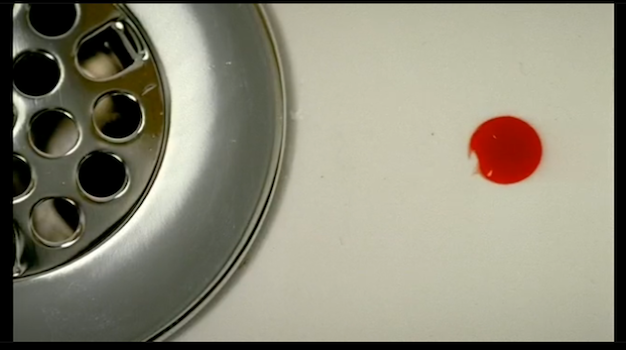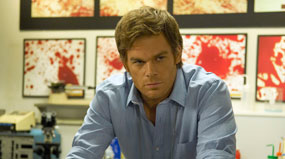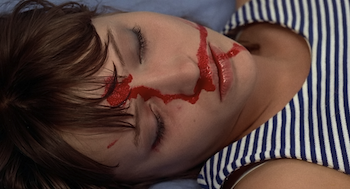That’s not blood, that’s music: Dexter’s musical seriality
Lisa Coulthard / University of British Columbia

In a recent article published in the journal Music, Sound and the Moving Image, Michele Hilmes questions the silence on sound and music in television studies. Arguing for the necessity of studying this essential aspect of television aesthetics, form and reception, Hilmes notes that television’s roots in radio as well as its streaming seriality distinguish television sound from film sound. While it is commonplace for scholars, technicians and artists working in television to note the fundamental noisiness of the medium (verbocentric and musical, television sound is rarely silent), there has been very little research in the area of television sound and music. Confronting this silence with the acoustic richness of television’s radio roots, Hilmes makes a case for considering the medium’s streaming structure as an integral part of its musical and aural fertility.
In my last column I related television’s seriality to the ritualistic and repetitive nature of the opening credits and the music associated with them. As I argued there, opening credits can attain an aesthetic and cultural impact and significance that cannot be subsumed under the functional analysis of the informational structure of the credits themselves. Credits frequently surpass the information they give and a large part of their aesthetic, stylistic and affective impact is the music associated with them. Whether a song, original score or a new version of a well-known hit, the opening music for a series plays a crucial role in the success and influence of not only the credit sequence but often the series as a whole.
Music also of course plays a large role in the paratextual economic synergies associated with a series: a good opening sequence can create a hit song as in Jace Everett’s “Bad Things” from True Blood, make a composer’s career, increase the popularity of a show or renew and redefine a series in a new season. For instance, the controversial new opening credits and song for Big Love’s Season 4 radically changed both song and visuals in order to reflect the changing emotional and narrative events of the series. While a number of series have changed opening credit songs and visuals over the years, the shift in Big Love’s opening can be read as indicative of a crucial thematic and narrative shift – the move from brightly lit ice skating accompanied by The Beach Boy’s “God Only Knows” to falling through darkness scored by the Engineers’ ambivalent and questioning “Home” is indicative of the changing lives and certainties of the characters in the series.
[youtube]http://www.youtube.com/watch?v=5RlfJ7fX_ZM[/youtube]
But beyond the credits alone, the role of music within television series offers insight into the fundamental differences between film and television sound outlined by Hilmes. For a composer associated with a series, the length, repetition and formal specificities of artistic creation are all impacted by the streaming seriality of the medium. Rather than creating a score for a single film, the television composer works across a changing landscape of narrational, thematic and characterological events and nuances. Creating motifs and themes that work throughout a large number of episodes is a far different challenge than composing for a single film. Add to the greater overall use of music within television and the aesthetic changes and challenges that come with working with a number of different directors, the art of the television composer provides opportunities, challenges and rewards that shape the style, form and aesthetics of his or her work.
For instance, if we consider the work of Daniel Licht, the composer for Showtime’s Dexter, we note the prominence of music in creating the overall tone and atmosphere for the show. Visually the show foregrounds the paradoxical parallel of its brightly lit and colourful Miami locale and Dexter’s “dark passenger” of serial killing. This is immediately palpable in the opening designed by Digital Kitchen that places the everyday in the context of the grotesquely violent (like American Psycho, Dexter’s opening uses food as a visual analogue for blood), a contextualization that is stressed by the Rolfe Kent’s opening music, a blend of upbeat Latin rhythms with a slight sinister edge. This visual paradox of brightness and beauty and sinister ugliness is carried throughout the series, but is most palpable in the series’ emphasis on blood splatter patterns, especially visible in Dexter’s lab where the bright, saturated vibrancy of red stands out against white, clinical backgrounds. In the opening credits, crime scene, lab and images hanging from the walls of Dexter’s office, blood becomes a purely aesthetic subject: blood splatters take on the visual style of abstract art.
[youtube]http://www.youtube.com/watch?v=VR38gwzJhLg[/youtube]
This predominance of blood is musically evident as well, as Licht’s signature “blood theme” is almost as prevalent as Dexter’s own musical theme in the soundscape of the series. Given the series’ focus on a blood splatter analyst/ vigilante serial killer, it is not surprising that Licht’s music for Dexter articulates the dark, uncanny and grotesque. Emphasizing unusual percussion (Licht even uses human bones as percussive instruments) and minor keys, Licht’s music stresses the intensity of action and the melancholic sadness that shape Dexter’s character. In combination with the foregrounded voiceover (Dexter’s stream of consciousness/ direct address to the viewer) and elaborate and viscerally present sound effects, the music of Dexter provides the context and content of much of the series’ violent and bloody action.

In combination with the musical scoring, foley and sound effects concentrate attention on the sounds of bodily violence and dismemberment. For instance, in addition to the “blood theme,” there are musical cues tied to Dexter’s signature cheek slicing, his gathering of killing tools and his acts of murder. Sound effects and foley are also played loud in the mix, especially those relating to violent physical action such as blood splatters, body blows and plastic bags containing body parts being dumped over the side of Dexter’s boat. These moments usually downplay dialogue as music and effects take over to convey action and bodily presence.
In Dexter violence and the body have an acoustic presence equal to that of any character – tools sing, blood has tunes and body blows weave in out of the percussive elements of Licht’s score. Each episode features repeated themes and motifs with certain developments, variations and nuances across the series as a whole, but the dominance of the “blood” and “Dexter” themes unifies the action across the series and offers an affective and narrational context that moves beyond the weekly repetition of content. A serial killer is by definition repetitive, so a television series on serial killing suggests a kind of synchronicity of form and content – the seriality of television was made for the serial killer and Dexter’s wild popularity confirms this. Sold on soundtracks, posted on youtube, discussed in internet forums, Licht’s score holds a prominent place in this popular seriality and it is in large part recognized as a key aspect in making uncanny and dark the brightly lit and colourful mise en scene and cinematography.
Blood is a crucial part of this bright mise en scene – a primary colour most often framed against blinding whiteness, blood becomes an aesthetic element in Dexter and, as we have noted, a musical one. Emphasizing this musicality, my title takes its cue from Godard’s famous “that’s not blood, that’s red”: Godard’s answer to attacks on the violence of his films reminds his viewers of the aesthetic, performative and artificial nature of cinema.

Godard insists that blood in film is first and foremost an element of aesthetics, cinematography and mise en scene, and television crime shows such as Dexter remind us that music is part of this mix as well. As a blood splatter analyst, Dexter always reminds us that blood tells stories, but if we listen closely, we also realize that it sings.
Image Credits:
1. http://www.d-kitchen.com/projects/dexter-main-title#
2. http://www.sho.com/site/dexter/episodes.do
3. http://pjmix.tumblr.com/post/377787059/jean-luc-godard-pierrot-le-fou-1965
Pingback: Women Stuff Blog